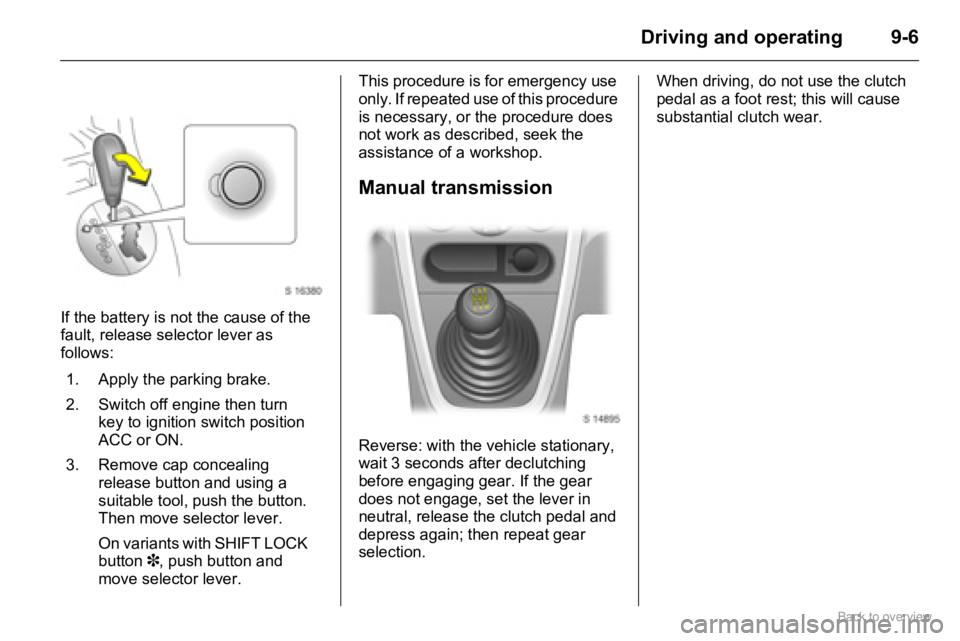2009 OPEL AGILA battery
[x] Cancel search: batteryPage 74 of 153

7-4 Infotainment system
Entering 4-digit security ID
When the Infotainment system is
switched on after the unit has been
removed or the battery has been
disconnected, the 4-digit security ID
must be entered, otherwise the unit is
inoperable.
“SEC” appears in the display when
the system is switched on. This will
not happen if the system is switched
off and back on again within
20 seconds.
To enter the user ID, proceed as
follows:Switch the Infotainment system back
on to operate: the system comes on
in radio mode.
If the wrong user ID is entered
10 times, “HELP” appears in the
display and the system cannot be
operated. Seek the assistance of a
workshop.
If you forget your user ID, seek the
assistance of a workshop.
Deleting 4-digit security ID
The stored user ID can be erased and
a new ID set at any time.To delete the existing user ID, repeat
steps 1 to 3 in “Setting 4-digit
security ID” then proceed as follows:
Set a new user ID as described in
“Setting 4-digit security ID”.
Operation
Switching on and off
Briefly press the bVOLUME rotary
knob f.
Setting the volume
Turn the bVOLUME rotary knob f. 1. Press the h button j and
numbered button 1e
simultaneously.
“- - - -” appears in the display.
2. Repeatedly press numbered
buttons 1e, 2b, 30 and
4d which correspond to the
digits of the user ID, until the
correct stored user ID is
displayed.3. Press and hold the PTY
button8 for approx.
2 seconds to enter the correct
stored user ID.
The Infotainment system is
switched off automatically.1. Repeatedly press numbered
buttons 1e, 2b, 30 and
4d which correspond to the
digits of the user ID, until the
correct stored user ID is
displayed.
2. Press and hold the PTY
button8 for approx.
2 seconds to enter the correct
stored user ID.
“- - - -” appears in the display
and the Infotainment system is
switched off automatically.
Page 86 of 153

8-5 Climate controls
Side air vents
To open and close side air vents, turn
horizontal knurled wheel to the left or
right.
Open side air vents when air
distribution rotary knob is set to
position M or L.
The air flow can be directed up and
down by tilting the slats up and down
using the central adjuster. Air flow is
directed sideways by turning the
horizontal knurled wheel to the left or
right.Depending upon the position of the
temperature rotary knob, cold or
heated air will be directed into the
vehicle via these air vents.
The air supply is increased by
switching on the fan.
Door window defroster vents
Air distribution rotary knob set to
lorV; cooled or heated air will be
directed onto the windscreen and
onto the door windows (mainly in the
area of the exterior mirrors).
Heated rear window,
heated exterior mirrors3
Operational only with engine running.
Control indicator in the button
illuminates when heating is
operational and extinguishes when
heating is switched off.
Turn off heating as soon as vision is
clear.
Rear window and exterior mirror
heating is switched off automatically
after approx. 15 minutes.
To avoid discharging the battery, do
not operate when you are just starting
the vehicle, or if there is a build up of
snow or ice.
Do not use sharp instruments or
abrasive cleaners on rear window or
exterior mirrors, and avoid scratching
or damaging their heating elements.
Press button Ü=On
Press button Ü again = Off
Page 92 of 153

9-5 Driving and operating
Stopping the vehicle
Engage parking brake and move
selector lever to position P. It will not
be possible to turn the ignition key to
the LOCK position unless the selector
lever is in positionP.
Rocking the vehicle
If it becomes necessary to rock the
vehicle to free it from water, ice, sand,
mud, snow or a dip, observe the
following:
Move the selector lever between R
and a forward gear in a repeat pattern
while applying light pressure to the
accelerator pedal when the vehicle is
in gear.
Do not spin the wheels or race the
engine and avoid sudden
acceleration.
Manoeuvring the vehicle
To manoeuvre the vehicle back and
forth during attempts to park or in
garage entrances, the creeping
movement can be utilized by
releasing the foot brake.
Never actuate the accelerator and
brake pedals simultaneously.
Fault
If there is a problem with the
automatic transmission, control
indicator
s flashes. The transmission
no longer shifts automatically.
Seek the assistance of a workshop to
rectify the cause of the fault.
Interruption of power supply
If the vehicle battery is flat, the
selector lever cannot be moved out of
position P.
Start the vehicle using jump leads 3
10-26.
Page 93 of 153

9-6Driving and operating
If the battery is not the cause of the
fault, release selector lever as
follows:This procedure is for emergency use
only. If repeated use of this procedure
is necessary, or the procedure does
not work as described, seek the
assistance of a workshop.
Manual transmission
Reverse: with the vehicle stationary,
wait 3 seconds after declutching
before engaging gear. If the gear
does not engage, set the lever in
neutral, release the clutch pedal and
depress again; then repeat gear
selection.When driving, do not use the clutch
pedal as a foot rest; this will cause
substantial clutch wear.
1. Apply the parking brake.
2. Switch off engine then turn
key to ignition switch position
ACC or ON.
3. Remove cap concealing
release button and using a
suitable tool, push the button.
Then move selector lever.
On variants with SHIFT LOCK
button3, push button and
move selector lever.
Page 97 of 153

9-10Driving and operating
Brake assist
Rapid powerful application of the
brake pedal automatically applies
maximum brake force amplification to
achieve the shortest possible braking
distance under full braking (brake
assist).
Maintain steady pressure on the
brake pedal for as long as full-on
braking is to continue. When the
brake pedal is released, the
maximum brake force amplification is
taken away.
Ride control systems
Electronic Stability Program
(ESP®) 3
The Electronic Stability Program
improves driving stability when
necessary, independently of the type
of road surface and the tyre grip. It
also prevents the drive wheels from
spinning.
The system monitors vehicle
movements. As soon as the vehicle
starts to swerve (understeers/
oversteers), engine output is reduced
(the sound of the engine changes)
and individual wheels are specifically
braked. This considerably improves
the driving stability of the vehicle on
snow and ice and on wet or slippery
road surfaces.
ESP
® is ready for operation as soon
as the ignition is switched on and the
control indicators
R, ESP and TCSS OFF extinguish.
When the ESP® comes into action,
control indicator
R flashes rapidly in
the instrument cluster. Some noise or
vibration may be apparent.ESP active control indicator 3 5-10.
Interruption of power supply
If the vehicle’s battery has been
disconnected and reconnected,
ESP
® is deactivated and control
indicator R flashes once per second.
Reactivate ESP® by driving in a
straight line at over 15 km/h (9 mph)
for a few seconds until flashing
ceases. Several seconds may lapse
before the control indicator
extinguishes, depending on road
conditions.
Caution
Do not let this special safety feature
tempt you into taking risks when
driving.
Traffic safety can only be achieved
by adopting a responsible driving
style.
Page 101 of 153

10-1Vehicle care
Vehicle care General information
Accessories and vehicle
modifications
We recommend the use of ‘Opel
genuine parts and accessories’
expressly released for your vehicle
type. Do not make any changes to the
vehicle’s electrical systems.
End-of-life vehicle recovery
Information on end-of-life vehicle
recovery centres and the recycling of
end-of-life vehicles is available at
www.opel.com.
Vehicle checks
Bonnet .................................. 10-2
Engine oil .............................. 10-3
Engine coolant ...................... 10-4
Windscreen/rear window
washer fluid ........................ 10-5
Windscreen/rear window
wipers ................................. 10-5
Brakes ................................... 10-6
Battery .................................. 10-6
Diesel fuel system, bleeding . 10-7
Bulb replacement .................. 10-7
Fuses .................................... 10-11
Wheels .................................. 10-15
Tyre repair kit 3 ..................... 10-18
Wheel changing .................... 10-22
Jump starting 3 ..................... 10-26
Towing .................................. 10-28
Interior care........................... 10-29
Exterior care ......................... 10-30
9 Warning
Only carry out engine
compartment checks when the
ignition is switched off.
The cooling fan can start to
operate unexpectedly, even when
the ignition is switched off.
9 Danger
Electronic ignition systems
generate very high voltages. Do
not touch the ignition system; high
voltage can be fatal.
Page 106 of 153

10-6 Vehicle care
Replacing rear window wiper
Lift wiper arm. Disengage wiper blade
as shown in illustration and remove.
Brakes
Brake pads worn to their minimum
thickness may generate a grinding
noise. It is possible to continue
driving.
Have your brake pads replaced as
soon as possible.
Do not brake unnecessarily hard
during the first 200 km (125 miles)
after new brakes have been fitted.Brake/clutch fluid level
The brake fluid level in the reservoir
must not be higher than the MAX
mark or lower than the MIN mark.
Use only approved high performance
brake fluid.Extreme cleanliness is important,
since brake fluid contamination can
lead to brake system malfunctions.
After correcting the brake fluid level,
seek the assistance of a workshop to
rectify the cause of the fluid loss.
Battery
The battery is maintenance-free.
Batteries are not to be treated as
household waste. They should be
disposed of at a designated collection
point for recycling.
Laying up the vehicle for more than
4 weeks can lead to battery
discharge. Disconnect battery from
on-board power supply by detaching
negative terminal.
Ensure that the ignition is switched off
before reconnecting the battery.
Control indicator Z illuminates in the
instrument cluster then extinguishes
after the engine is started when the
system has been correctly calibrated.
9 Warning
Brake fluid is poisonous and
corrosive. Do not allow it to
contact eyes, skin, fabrics or
painted surfaces; direct contact
may cause injuries and damage.
Page 107 of 153

10-7Vehicle care
Diesel fuel system, bleeding
It is possible to restart the engine if
the tank has been run dry.
With vehicle stationary, turn key to
ignition switch position ON for more
than 5 seconds, then turn to START.
If engine does not start, wait
approx.15 seconds before repeating
starting procedure.
If the engine will still not start, seek
the assistance of a workshop.
Bulb replacement
Before replacing a bulb, switch off
ignition and relevant switch.
Only hold new bulbs at base! Do not
touch the bulb glass with bare hands.
Replacement bulb must be in
accordance with data on base of
defective bulb. Do not exceed
wattage given on bulb base.
Headlamps
Battery removal
Diesel engines: for headlamp bulb
replacement on the battery side, it is
necessary to first disconnect and
remove the battery then remove the
coolant expansion tank and fuse box.
1. Switch off ignition and exterior
lamps.
2. Open bonnet and disconnect
battery by detaching negative (-)
terminal followed by positive (+)
terminal.3. Unscrew the retaining bolt using a
suitable tool and remove battery,
coolant expansion tank and fuse
box.
When reinstalling the battery,
reconnect the positive (+) terminal
first and then the negative (-)
terminal.